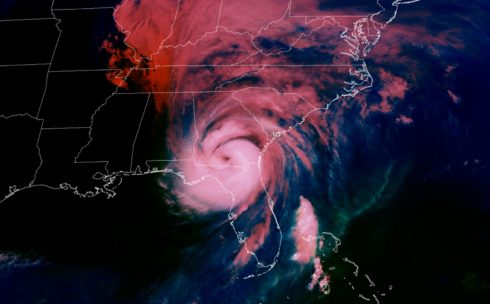Hurricane Helene has left a trail of destruction in its wake, causing the deaths of at least 43 people and leaving millions without power across the southeastern United States. The storm, which made landfall in Florida’s Big Bend region as a powerful Category 4 hurricane, wreaked havoc as it moved north into Georgia and the Carolinas, leaving widespread flooding, damaged homes, and downed power lines in its path. As rescue efforts continue, authorities are grappling with the immense scale of the disaster and the toll it has taken on the region.
Widespread Destruction Across Multiple States
Hurricane Helene’s powerful winds and heavy rains triggered massive flooding, leaving roads submerged and homes destroyed in several states. In Tennessee, 58 patients and workers were stranded on the roof of a hospital in the city of Erwin, as floodwaters from the Nolichucky River cut off rescue efforts by boat. The situation was so dire that helicopters from the Tennessee National Guard had to be deployed to bring them to safety. Meanwhile, in Florida’s coastal Pinellas County, five people lost their lives due to floodwaters, with additional fatalities reported in Georgia and the Carolinas.
Officials continue to assess the damage as rescue teams work tirelessly, using boats, helicopters, and large vehicles to reach those stranded in their homes. In South Carolina alone, the death toll has reached 17, according to CBS News, while North Carolina has reported at least two deaths. The widespread devastation has prompted Georgia Governor Brian Kemp to order 1,000 National Guard troops to assist in the rescue efforts as more than 150 roads remain closed, and many residents are still trapped.
Hurricane Helene Severe Flooding and Power Outages
The sheer size of Hurricane Helene, spanning nearly 420 miles, has caused extensive flooding across Florida, Georgia, and Tennessee. Storm surges along Florida’s Gulf Coast reached as high as 15 feet, submerging entire neighborhoods and leaving thousands of residents in need of evacuation. Rescue operations are ongoing, with more than 65 people pulled from floodwaters in Pasco County, Florida. In Manatee County, guests at a Ramada Inn had to be evacuated as water rushed into the hotel.
Millions remain without power as utility companies struggle to restore services amid the devastation. As of late Friday, more than three million homes and businesses across the southeastern U.S. were still without electricity, according to tracking site PowerOutage.us. In Georgia, over 1,300 traffic signals were out, adding to the chaos as emergency responders continue their efforts to restore some semblance of normalcy.
Unprecedented Hurricane Season with More Storms Expected
Hurricane Helene is the 14th most powerful storm on record to hit the U.S., following in the footsteps of other massive hurricanes like Ida in 2017 and Opal in 1996. With a diameter of 420 miles, the storm is one of the largest ever recorded, and its impact has been felt far and wide. According to the National Hurricane Center (NHC), Hurricane Helene’s storm surge reached 15 feet in some areas, contributing to the widespread flooding that has devastated coastal communities.
Officials warn that the hurricane season is far from over, with more storms expected to develop in the coming months. The National Oceanic and Atmospheric Administration (NOAA) has predicted that up to 25 named storms could form during the 2024 hurricane season, with between eight and 13 developing into hurricanes. With sea surface temperatures in the Gulf of Mexico up to two degrees Celsius higher than normal, conditions are ripe for more destructive storms to emerge before the hurricane season ends on November 30.
As communities across the southeastern U.S. begin to assess the damage, the long road to recovery lies ahead. Federal Emergency Management Agency (FEMA) officials have urged residents to remain vigilant, emphasizing that while the storm may have passed, the dangers of flooding, high winds, and even tornadoes remain.














